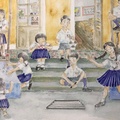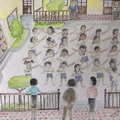*Continued from part 2 , the following story is told by the author's father, Masao Nakachi, from a first-person narration.....
I had finally arrived in Jauja. I was greeted by a beautiful blue sky crossed by few white clouds and a pleasant, soft, cool breeze. The city of Lima, almost always gray, bathed in sadness, had been left behind. I came determined to enter the Jauja sanatorium because the hard work and the humid climate of Lima seemed to have affected my health. I hoped to spend at least a month resting on the balcony, looking at the mountains and the incomparable landscape that surrounded Jauja. I wanted to feel like one of the characters I had read in “The Magic Mountain” by Thomas Mann, seeing the blue sky and feeling the cold, dry wind on my face; dreaming, free of worries.
Several times I knocked on the door of the sanatorium trying to be received. The nuns wouldn't admit me because I wasn't sick. I was young and stubborn, I didn't give up. Moved, or perhaps tired by my insistence, they let me stay as “topiquero” or topic assistant. Almost all patients had some degree of pulmonary tuberculosis. Being a consumptive was like being a leper everywhere in the world. They shunned them and isolated them. But in Jauja everyone was equal. There were princes and princesses, ministers, counts, rich and poor. They all came for the healing climate of Jauja.
At first I was somewhat afraid of getting infected. As the days passed, my fears faded. All day he was busy caring for patients. Most of them remained silent. With some I could talk and laugh a little. They told me that the first patient had been a minister from China. I listened, fascinated by the patients, to what they told me about France, England and other places that I don't remember. I felt happy.
During the week they sometimes sent me to Huancayo to run some errands. Soon, due to my jovial and friendly nature, I made several friends with whom I used to spend my free time.
My departure days were Sundays and I went to Huancayo. I put on my new suit, my filter hat and my glasses that made me look like an intellectual, in case I ran into Kiyomi and her family. They had told me that a pretty Japanese girl used to walk with her family in the Plaza Central Huamanmarca. I was excited to meet Kiyomi. In reality, I was hoping to see it pass by, even if it was from afar (as they said in the mountains).
One day I saw her and wanted to say hello. He looked at me as if recognizing me and smiled shyly. Her mother, very upset, pulled her by the arm and quickened her pace, making her way through the crowd of walkers, street vendors and children.
I didn't give up. Every Sunday, at dusk, I would stand on the corner in front of his house. During the day, the family never closed the gate of the house where they lived. It always stayed open late, especially on Sundays.
They watched people pass by. Some just waved, others looked out and made banal comments. A few stopped to tell them the news of the city. Sometimes, I could see Kiyomi coming and going in the yard.
A neighbor used to go visit them with the excuse of having cooked a lot of mote (mountain corn). He brought a big bowl for everyone and stayed “gossiping” for a long time. She always saw me standing in front of the house. I think they sympathized with me because I told them all the time about the countryman who had come from Lima and worked with the nuns in Jauja. Upon hearing it, the mother and sisters felt very upset, although they tried to hide it.
His mother started closing the gate early on Sundays. However, Kiyomi went up to the balcony with the excuse of closing the windows, because every afternoon the wind blew very strong and could affect her mother's health. From there he could see me for a few moments. I looked back at him with sadness in my eyes. When night came I had to return to Jauja. And slowly I walked away down the street.
When the war with Japan began, we Japanese in Huancayo did not suffer as much as our countrymen in Lima. Most of us had come to Huancayo for health reasons. Kiyomi's father, leaving his job as a teacher and director of a Japanese school in Vilcahuaura, near Lima, had taken Kiyomi's mother to Huancayo to recover from a lung illness. Kiyomi worked in the Murayama family home, in Miraflores, and had to leave it to take care of her mother.
Throughout the war there was looting, mistreatment and deportations in the capital. Japanese schools were confiscated by the government. The Lima Nikko school became a national school. Much of the Jishuryo school land passed into the hands of a military man. Many lost their businesses and property. It was a very painful, hard and sad time.
Kiyomi's father had started teaching Japanese in Huancayo, but was called to Lima to be deported. Due to a fortunate error in the reading of his last name (it was listed as Senda, instead of Chida), he had time to hide at a friend's house in Lima. He stayed there until the police stopped monitoring his house in Huancayo. It was many months.
When the father returned to Huancayo and found out about my interest in Kiyomi. He didn't accept me. I felt very sad and disappointed. Although he was a kind-hearted man, he was hard on me. He was concerned about my lack of secure work and my Okinawan origin. At that time relations with the additional sentences in red were not acceptable to those of Okinawa. A long time passed until, finally, one day he allowed me to enter the courtyard. Sitting under the mountain sun, we talked at length. He could see Kiyomi peering anxiously out one of the windows.
I quit my job at the Jauja sanatorium. Mr. Yamashita, who had already made money, wanted to retire and transferred his restaurant near the Central Plaza to me. I worked hard and did well. Chida sensei, Kiyomi's father, then agreed for me to marry her. It was the best thing that could have happened to me in my life.
My first daughter, Carmen, was born in the midst of hard times, sadly passing away a few months after being born. Then Graciela, Mercedes, Jorge and Luis came. Even though we often had to leave them at home alone due to work, they grew up healthy, happy, and playful. When Graciela was four years old and approaching school age, I decided to return to Lima, where children could have a better education.
I went to Lima to prepare our return to the capital. I got a cousin to let me have my family in a room on the roof. We couldn't go down nor did we have access to the rest of the house. We didn't stay long. We moved to a room in Surquillo, in a “one-pipe” alley. It was a populous and dangerous neighborhood, especially for my children, but I couldn't afford another one and it was close to the cafe where I was working. It was hard for a while.
One day, Kiyomi told me that there was a cook job at Jishuryo Elementary School. At first, I refused because of the feeling of uncertainty about the type of work, but she continued to insist. They offered not only work, but also accommodation for the family. It was located in Lince, which was a safer neighborhood. We decided to go.
One night, Kiyomi, carrying Chabuquita, who had just been born, and hand in hand with my four children, we arrived at Jishuryo, where Victor, the school's caretaker and janitor, was waiting for us.
After crossing a long, dark corridor, we were greeted by the silence of the empty patios and halls. Only the rustling of the trees moved by the wind could be heard. We arrived at a room dimly lit by a worn-out light bulb that let me see the tired faces of Kiyomi and my children sleeping in our new home.
© 2023 Graciela Nakachi







